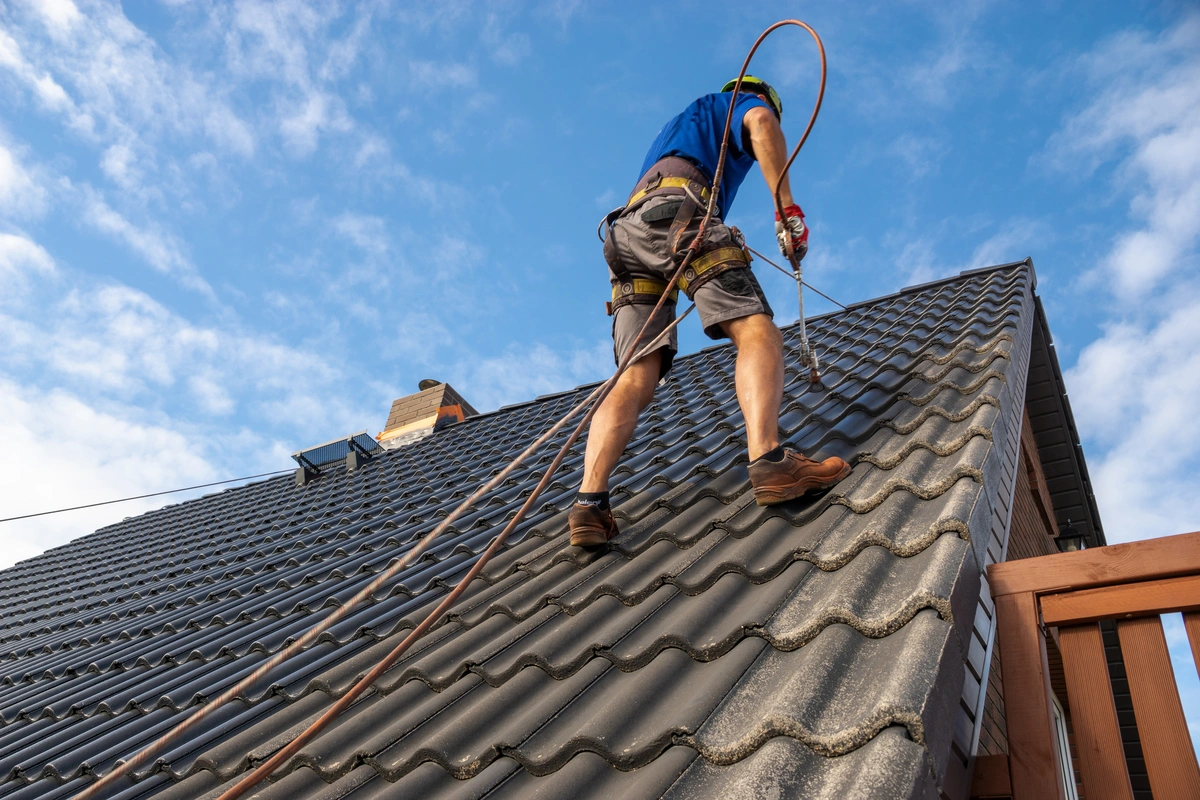Imagine pulling into your driveway on a bright Gainesville afternoon only to notice your roof looking faded and worn.
A fresh coat of paint might seem like a quick fix. But in Florida’s heat, humidity, and storms, it’s not that simple.
Before making a decision, it’s important to understand how Gainesville’s unique weather patterns and home styles affect roof paint longevity, maintenance, and overall performance.
Let’s go over the key factors homeowners should consider.
Key Takeaways
- Not all roofs can be painted. Asphalt and metal work, but clay, slate, and wood shingles don’t hold paint well.
- Florida’s climate shortens paint lifespan, with extreme heat, humidity, and storms causing peeling and moisture damage.
- Safety is a major concern, as steep roofs, slippery surfaces, and intense sun exposure make DIY painting risky.
- Painted roofs require frequent maintenance, needing touch-ups and repainting every 5–7 years to stay in good condition.
- A professional inspection can save you time and money, helping you decide if painting, repairs, or a new roof is the better investment.
1. Florida’s Weather Can Make or Break a Roof Paint Job
Florida’s weather can wear down a painted roof fast, especially in Gainesville, Haile Plantation, Newberry, and Ocala. Summer heat (90–100°F) can cause paint to crack and peel, while high humidity, which stays above 75% year-round, also poses a problem.
Trapped moisture increases the risk of mold, algae growth, and shingle deterioration, especially in shaded areas.
With over 50 inches of annual rainfall, fresh paint can wash away before curing, and hurricane-season winds make painted shingles more brittle.
Best Time to Paint in Florida
The best time to paint is late winter or early spring, but even then, moisture remains a concern, especially in shaded or low-lying areas in Newberry and Ocala.
2. Painting Your Roof Can Be Dangerous Without Proper Safety Measures
Roof painting isn’t just a DIY project. It comes with serious risks, especially in Gainesville and surrounding areas.
Here are a few essential key safety hazards to consider:
- Slippery Surfaces – Morning dew and wet paint can make shingles dangerously slick.
- Intense Sun Exposure – Florida’s 95°F+ heat increases the risk of heat exhaustion or dehydration.
- Steep & Multi-Story Roofs – Homes in Haile Plantation and Tioga have complex designs, making roof work more hazardous.
- Shaded Mold & Wet Leaves – Properties near Kanapaha Botanical Gardens and Millhopper face extra slip risks.
- Essential Safety Gear Required – A harness, stabilizers, and specialized ladders are a must.
Pro Tip: If you’re not experienced with working at heights, hiring a professional roofing contractor is the safest option.
3. Not All Roof Types Are Meant to Be Painted
Ever wonder if you can just paint over your roof for a fresh new look?
Not all roofing materials handle paint well. Some absorb moisture, crack, or deteriorate faster when coated, leading to expensive damage.
Here are some of the most common roof types and how their materials respond to paint.
| Roof Materials | Can It Be Painted? | Considerations |
| Asphalt Shingles | Yes | Requires breathable, acrylic latex roof paint. Traps moisture if applied incorrectly, leading to mold or rot. |
| Metal Roofing | Yes | Can be repainted but needs a rust-resistant primer to withstand heavy rain and humidity. |
| Clay or Slate Tiles | No | Paint won’t adhere well and may crack under extreme heat. |
| Wood Shingles | No | Painting traps moisture, causing rot. Staining is a better option. |
While some roofs can be painted, it’s not always the best solution. Factors like material, moisture retention, and Florida’s climate all impact longevity.
If your roof isn’t ideal for painting, consider alternatives like cool roof coatings for better energy efficiency or a professional inspection to explore long-term solutions.
4. Using the Right Paint and Application Method Matters
So if your roof can be painted, choosing the right materials and techniques is key to making it last. The wrong paint or application method can lead to peeling, trapped moisture, and even higher energy costs.
Acrylic latex roof paint is the best option because it allows shingles to breathe and prevents moisture buildup. Regular exterior house paint should be avoided, as it won’t adhere properly and will deteriorate quickly under Florida’s intense heat.
Here are the best application methods you can choose from:
Sprayers
They provide even, professional-looking coverage and are the fastest method for large areas. However, they require skill to control overspray and ensure an even coat. It’s best to use a low-pressure, high-volume sprayer for optimal results.
Rollers
They offer better control and minimize overspray, making them ideal for sloped roofs. However, they may not reach deep into shingle crevices, so applying multiple coats is often necessary. A long-nap roller works best for textured surfaces like shingles.
Brushes
Best for detailed touch-ups, edges, and small sections, but impractical for an entire roof. They ensure paint gets into small areas but require more time and effort. Use a high-quality synthetic brush for better coverage and durability.
Key Tip: Always apply paint in thin, even coats to prevent moisture from getting trapped and causing long-term damage. Let each coat fully dry before applying the next for the best results.
5. Longevity and Maintenance are Also Important
Unlike new shingles, paint is not a permanent solution. In Florida, it requires frequent upkeep to prevent damage from heat, humidity, and storms. In Gainesville, Haile Plantation, Newberry, and Ocala, where tree cover and moisture levels are high, painted roofs can wear down even faster.
Here are a few things to expect with a painted roof:
Short Lifespan
Painted shingles typically last 5–7 years, requiring more frequent repainting, especially in Gainesville and Ocala, where storms and strong winds can accelerate chipping and peeling.
Moisture Risks
Florida’s high humidity can trap moisture under paint, causing mold and premature roof deterioration. This is especially concerning in Newberry and Haile Plantation, where dense tree cover creates damp shaded areas that heighten the risk of water damage.
Ongoing Maintenance
Keeping a painted roof in good condition requires regular touch-ups and sealing. In areas with high tree coverage, like Haile Plantation, falling leaves and algae can speed up paint wear, increasing maintenance demands.
Key Tip: If your roof needs frequent touch-ups, it may be more cost-effective to invest in new shingles designed to withstand Florida’s climate rather than repeatedly repainting. A roofing professional can help determine the best long-term option for your home.
Give Your Roof the Care It Deserves
Painting your roof might seem like a quick upgrade, but in Florida’s challenging climate, it’s not always the best move. Instead of dealing with fading paint and frequent touch-ups, make sure your roof is truly built to last.
A professional inspection can help you determine the right solution, whether it’s repairs, replacement, or a smarter alternative.
At Worthmann Roofing, we’re here to guide you toward the best choice for your home. Call 352-472-3228 today to schedule an inspection and get your free estimate!



